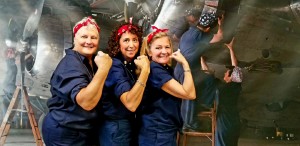By David Fleet
Editor
For 16 years Kathy Bolton donned a tool belt, picked up a hammer and went to work.
“Building houses was once a man’s job,” said Bolton, a Hadley Township resident and former construction worker . “Women should be empowered to accomplish their dreams—equal pay for equal work.”
. “Women should be empowered to accomplish their dreams—equal pay for equal work.”
Bolton expressed her equality on Oct. 14 when she joined 3,755 people dressed as Rosie the Riveters in an effort to set a new world record at Eastern Michigan University’s Convocation Center. In attendance were 57 original World War II Roises.
The cultural icon, Rosie the Riveter of World War II, represents the women who worked in factories and shipyards during World War II as millions of men were serving in the military.
The number of Rosies were verified by independent judges and submitted to the Guinness World Records.
“We feel it was a good count and consistent with the rules,” said David Callanan, of the Yankee Air Museum who helped coordinate the event. “It could take up to six months to verify the count.”
If verified by Guinness it would top the old record of 2,265 Rosies set in 2016 at the National Rosie the Riviter Park, Calif.
The motivation to break the worlds record was a desire to stand up and be counted, added Bolton.
“We felt a responsibility, a mindset to set a new record,” she said. “You have to show up, you have to be counted. The traffic getting into Eastern Michigan University was awful, it rained and it took many hours for all of us to be counted. But, it was also very powerful. To see the women with the Rosie outfits on, walking with their daughters and pushing baby Rosies in strollers was really moving.”
These women riveted, welded, kept the railroads running, conducted street cars, typed and filed, sewed parachutes, and played pro baseball.
“From the example of Rosie women now realized they can have a big impact on change,” she said. “Because of her they can decide to go out and have a career or stay at home and raise children. Stay at home moms have a tough job, one that should never be minimized. You can be a Rosie at home—it’s all about choices. While the Rosies did much for the war effort, it did just as much to empower women today to follow their dreams.”
Requirements consisted of dark blue work clothes, red socks, dark shoes with closed toes and red and white polka dot bandannas.
The Yankee Air Museum’s interests in setting a Guinness World Record for the largest gathering of people dressed as Rosie the Riveter were twofold, said Callanan.
“First the museum wants people to remember the contribution of women to the home front defense effort in World War,” said Callanan. “Two, by stepping into the industrial workplace at a time when men left their jobs and went overseas for military operations. Without necessary armaments, soldiers, sailors, marines and airmen cannot complete their mission.”
“Second, it is important to underscore the facts that women succeeded in the workplace,” he said. “They produced materials, components and assemblies often superior to that of men. These facts are evidenced in the production of B-24 Liberator bombers produced here at Historic Willow Run Airport where Yankee Air Museum is raising funds to renovate a portion of the Bomber Plant.”
The Willow Run Bomber Plant near Ypsilanti was built in 1941, and produced more than 8,600 B-24 Liberator bombers during WWII. It was the largest factory under one roof in the world at 3 million square feet in size, with two half-mile-long assembly lines. Willow Run employed 42,000 workers.
